brakes Hyundai Grandeur 2002 Owner's Manual
[x] Cancel search | Manufacturer: HYUNDAI, Model Year: 2002, Model line: Grandeur, Model: Hyundai Grandeur 2002Pages: 230, PDF Size: 3.82 MB
Page 55 of 230
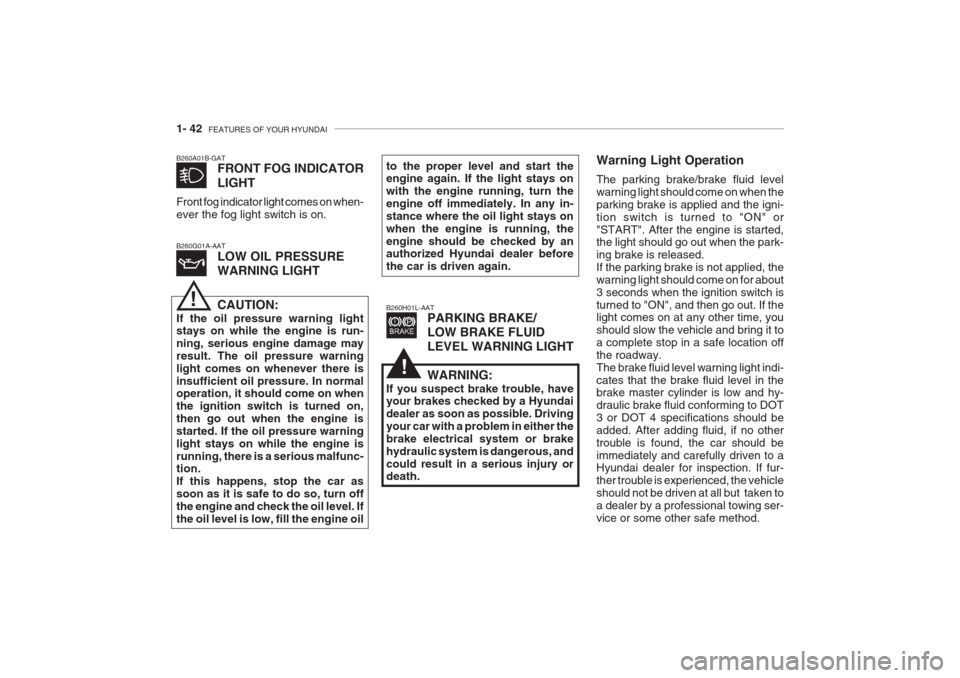
1- 42 FEATURES OF YOUR HYUNDAI
B260A01B-GAT
FRONT FOG INDICATOR LIGHT
Front fog indicator light comes on when- ever the fog light switch is on. B260G01A-AAT LOW OIL PRESSURE WARNING LIGHT CAUTION:
If the oil pressure warning light stays on while the engine is run- ning, serious engine damage mayresult. The oil pressure warninglight comes on whenever there isinsufficient oil pressure. In normal operation, it should come on when the ignition switch is turned on,then go out when the engine isstarted. If the oil pressure warninglight stays on while the engine isrunning, there is a serious malfunc- tion. If this happens, stop the car assoon as it is safe to do so, turn offthe engine and check the oil level. Ifthe oil level is low, fill the engine oil to the proper level and start the engine again. If the light stays on with the engine running, turn theengine off immediately. In any in-stance where the oil light stays onwhen the engine is running, theengine should be checked by an authorized Hyundai dealer before the car is driven again.
!B260H01L-AAT
PARKING BRAKE/ LOW BRAKE FLUID
LEVEL WARNING LIGHT
WARNING:
If you suspect brake trouble, have your brakes checked by a Hyundai dealer as soon as possible. Drivingyour car with a problem in either thebrake electrical system or brakehydraulic system is dangerous, andcould result in a serious injury or death. Warning Light Operation The parking brake/brake fluid level warning light should come on when theparking brake is applied and the igni-tion switch is turned to "ON" or"START". After the engine is started, the light should go out when the park- ing brake is released.If the parking brake is not applied, thewarning light should come on for about3 seconds when the ignition switch isturned to "ON", and then go out. If the light comes on at any other time, you should slow the vehicle and bring it toa complete stop in a safe location offthe roadway.The brake fluid level warning light indi-cates that the brake fluid level in the brake master cylinder is low and hy- draulic brake fluid conforming to DOT3 or DOT 4 specifications should beadded. After adding fluid, if no othertrouble is found, the car should beimmediately and carefully driven to a Hyundai dealer for inspection. If fur- ther trouble is experienced, the vehicleshould not be driven at all but taken toa dealer by a professional towing ser-vice or some other safe method.
!
Page 56 of 230
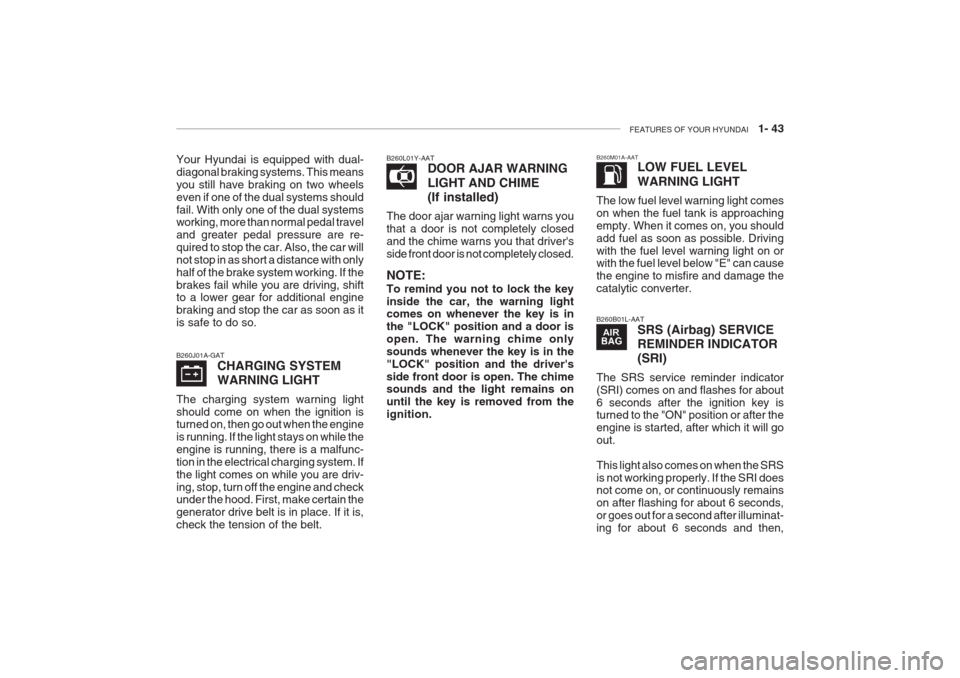
FEATURES OF YOUR HYUNDAI 1- 43
Your Hyundai is equipped with dual- diagonal braking systems. This meansyou still have braking on two wheelseven if one of the dual systems shouldfail. With only one of the dual systems working, more than normal pedal travel and greater pedal pressure are re-quired to stop the car. Also, the car willnot stop in as short a distance with onlyhalf of the brake system working. If thebrakes fail while you are driving, shift to a lower gear for additional engine braking and stop the car as soon as itis safe to do so. B260J01A-GAT
CHARGING SYSTEM WARNING LIGHT
The charging system warning light should come on when the ignition is turned on, then go out when the engine is running. If the light stays on while theengine is running, there is a malfunc-tion in the electrical charging system. Ifthe light comes on while you are driv-ing, stop, turn off the engine and check under the hood. First, make certain the generator drive belt is in place. If it is,check the tension of the belt. B260L01Y-AAT
DOOR AJAR WARNING
LIGHT AND CHIME (If installed)
The door ajar warning light warns you that a door is not completely closedand the chime warns you that driver'sside front door is not completely closed. NOTE: To remind you not to lock the key inside the car, the warning light comes on whenever the key is in the "LOCK" position and a door isopen. The warning chime onlysounds whenever the key is in the"LOCK" position and the driver'sside front door is open. The chime sounds and the light remains on until the key is removed from theignition. B260M01A-AAT
LOW FUEL LEVEL WARNING LIGHT
The low fuel level warning light comes on when the fuel tank is approachingempty. When it comes on, you shouldadd fuel as soon as possible. Drivingwith the fuel level warning light on or with the fuel level below "E" can cause the engine to misfire and damage thecatalytic converter. B260B01L-AAT SRS (Airbag) SERVICE REMINDER INDICATOR(SRI)
The SRS service reminder indicator (SRI) comes on and flashes for about6 seconds after the ignition key is turned to the "ON" position or after the engine is started, after which it will goout. This light also comes on when the SRS is not working properly. If the SRI does not come on, or continuously remains on after flashing for about 6 seconds,or goes out for a second after illuminat-ing for about 6 seconds and then,
Page 79 of 230

1- 66 FEATURES OF YOUR HYUNDAI
B550A02Y-AAT HIGH-MOUNTED REAR STOP LIGHT (If Installed) In addition to the lower-mounted rear stoplights on either side of the car, thehigh mounted rear stoplight in the cen-ter of the rear window also lights whenthe brakes are applied. B550A03L
To open the trunk lid, insert the key and turn it clockwise to unlock. Thetrunk compartment light illuminateswhen the trunk lid is opened.
NOTE:
o If a person is locked in the trunk
by one's own will or by another person or by accident, pull the emergency trunk release lever on the driver's side of the insidepanel of the trunk. This will openthe trunk lid.
o Hyundai recommends that cars be kept locked and keys be kept out of the reach of children, and that parents teach their childrenabout the dangers of playing intrunks. B540C01Y-AAT To unlock using the key
B540C03L
WARNING:
Parents should teach children about the emergency trunk release lever in their vehicle and how to open thetrunk lid if they are accidentallylocked in the trunk.
!
Page 87 of 230
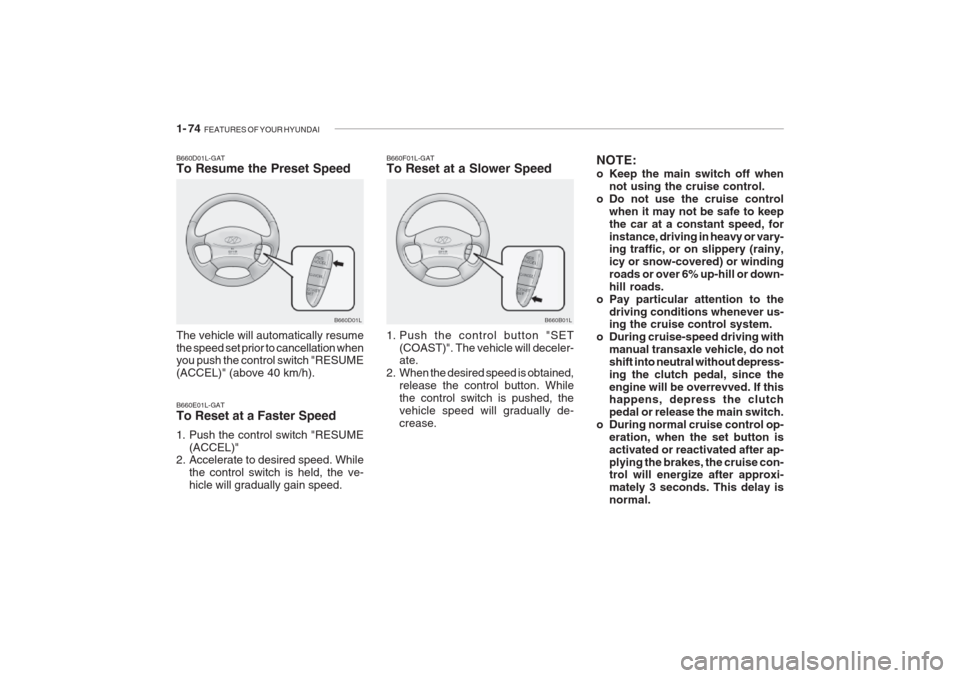
1- 74 FEATURES OF YOUR HYUNDAI
NOTE:
o Keep the main switch off when
not using the cruise control.
o Do not use the cruise control
when it may not be safe to keep the car at a constant speed, forinstance, driving in heavy or vary- ing traffic, or on slippery (rainy, icy or snow-covered) or windingroads or over 6% up-hill or down-hill roads.
o Pay particular attention to the
driving conditions whenever us- ing the cruise control system.
o During cruise-speed driving with
manual transaxle vehicle, do not shift into neutral without depress-ing the clutch pedal, since theengine will be overrevved. If this happens, depress the clutch pedal or release the main switch.
o During normal cruise control op- eration, when the set button isactivated or reactivated after ap-plying the brakes, the cruise con- trol will energize after approxi- mately 3 seconds. This delay isnormal.B660D01L-GAT To Resume the Preset Speed The vehicle will automatically resume the speed set prior to cancellation when you push the control switch "RESUME (ACCEL)" (above 40 km/h). B660D01L
B660E01L-GAT To Reset at a Faster Speed
1. Push the control switch "RESUME (ACCEL)"
2. Accelerate to desired speed. While
the control switch is held, the ve- hicle will gradually gain speed.B660F01L-GAT To Reset at a Slower Speed
1. Push the control button "SET(COAST)". The vehicle will deceler- ate.
2. When the desired speed is obtained, release the control button. While the control switch is pushed, thevehicle speed will gradually de-crease. B660B01L
Page 135 of 230
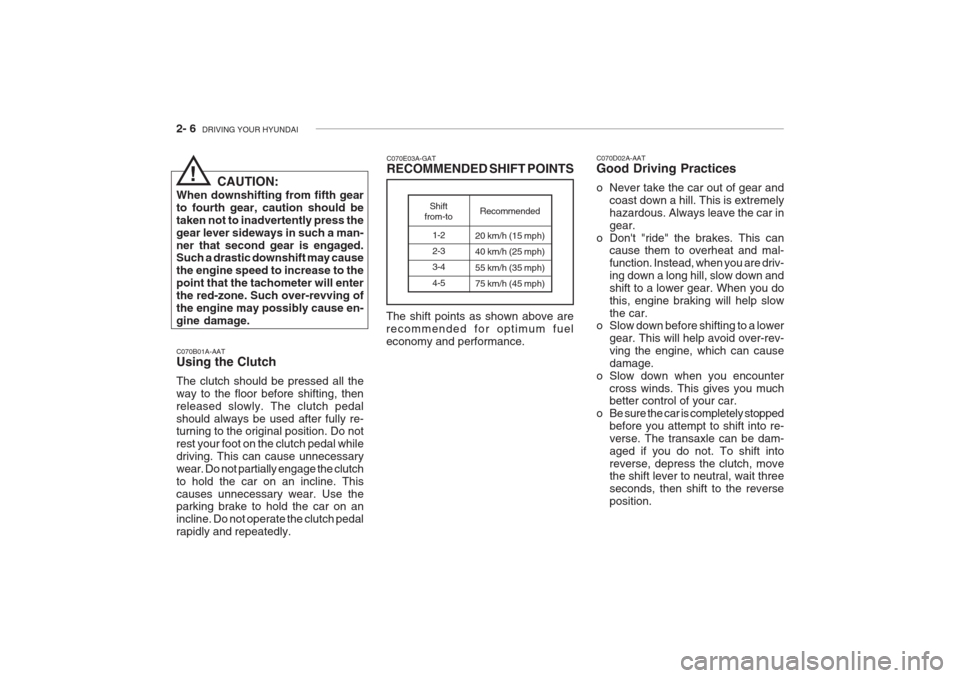
2- 6 DRIVING YOUR HYUNDAI
C070D02A-AAT Good Driving Practices
o Never take the car out of gear and
coast down a hill. This is extremely hazardous. Always leave the car ingear.
o Don't "ride" the brakes. This can cause them to overheat and mal-function. Instead, when you are driv-ing down a long hill, slow down andshift to a lower gear. When you dothis, engine braking will help slowthe car.
o Slow down before shifting to a lower
gear. This will help avoid over-rev-ving the engine, which can causedamage.
o Slow down when you encounter
cross winds. This gives you much better control of your car.
o Be sure the car is completely stopped
before you attempt to shift into re- verse. The transaxle can be dam-aged if you do not. To shift intoreverse, depress the clutch, move the shift lever to neutral, wait three seconds, then shift to the reverseposition.
C070B01A-AAT Using the Clutch The clutch should be pressed all the way to the floor before shifting, thenreleased slowly. The clutch pedalshould always be used after fully re- turning to the original position. Do not rest your foot on the clutch pedal whiledriving. This can cause unnecessarywear. Do not partially engage the clutchto hold the car on an incline. Thiscauses unnecessary wear. Use the parking brake to hold the car on an incline. Do not operate the clutch pedalrapidly and repeatedly. CAUTION:
When downshifting from fifth gearto fourth gear, caution should betaken not to inadvertently press thegear lever sideways in such a man-ner that second gear is engaged. Such a drastic downshift may cause the engine speed to increase to thepoint that the tachometer will enterthe red-zone. Such over-revving ofthe engine may possibly cause en-gine damage. C070E03A-GAT RECOMMENDED SHIFT POINTS
1-2 2-33-4 4-5
Shift
from-to Recommended
20 km/h (15 mph) 40 km/h (25 mph) 55 km/h (35 mph) 75 km/h (45 mph)
The shift points as shown above are recommended for optimum fueleconomy and performance.
!
Page 139 of 230
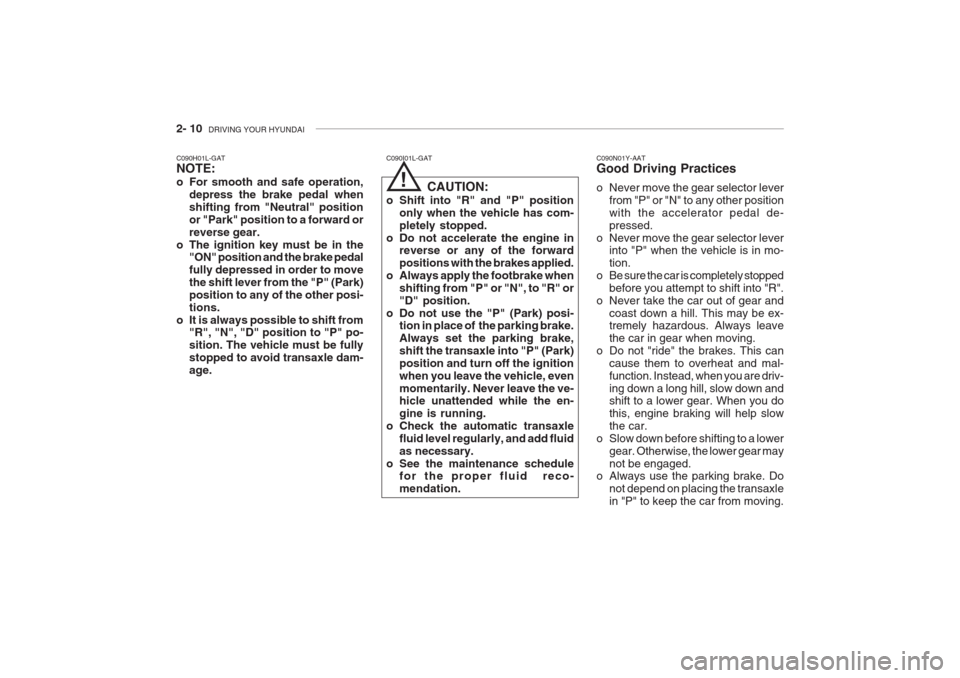
2- 10 DRIVING YOUR HYUNDAI
C090H01L-GAT NOTE:
o For smooth and safe operation,
depress the brake pedal when shifting from "Neutral" positionor "Park" position to a forward orreverse gear.
o The ignition key must be in the "ON" position and the brake pedalfully depressed in order to movethe shift lever from the "P" (Park)position to any of the other posi-tions.
o It is always possible to shift from "R", "N", "D" position to "P" po-sition. The vehicle must be fullystopped to avoid transaxle dam-age. C090I01L-GAT
CAUTION:
o Shift into "R" and "P" position only when the vehicle has com-pletely stopped.
o Do not accelerate the engine in reverse or any of the forwardpositions with the brakes applied.
o Always apply the footbrake when
shifting from "P" or "N", to "R" or"D" position.
o Do not use the "P" (Park) posi- tion in place of the parking brake.Always set the parking brake,shift the transaxle into "P" (Park)position and turn off the ignitionwhen you leave the vehicle, evenmomentarily. Never leave the ve- hicle unattended while the en- gine is running.
o Check the automatic transaxle fluid level regularly, and add fluidas necessary.
o See the maintenance schedule for the proper fluid reco-mendation. C090N01Y-AAT Good Driving Practices
o Never move the gear selector lever
from "P" or "N" to any other position with the accelerator pedal de-pressed.
o Never move the gear selector lever into "P" when the vehicle is in mo-tion.
o Be sure the car is completely stopped
before you attempt to shift into "R".
o Never take the car out of gear and
coast down a hill. This may be ex- tremely hazardous. Always leave the car in gear when moving.
o Do not "ride" the brakes. This can cause them to overheat and mal-function. Instead, when you are driv-ing down a long hill, slow down and shift to a lower gear. When you do this, engine braking will help slowthe car.
o Slow down before shifting to a lower gear. Otherwise, the lower gear maynot be engaged.
o Always use the parking brake. Do
not depend on placing the transaxlein "P" to keep the car from moving.
!
Page 140 of 230
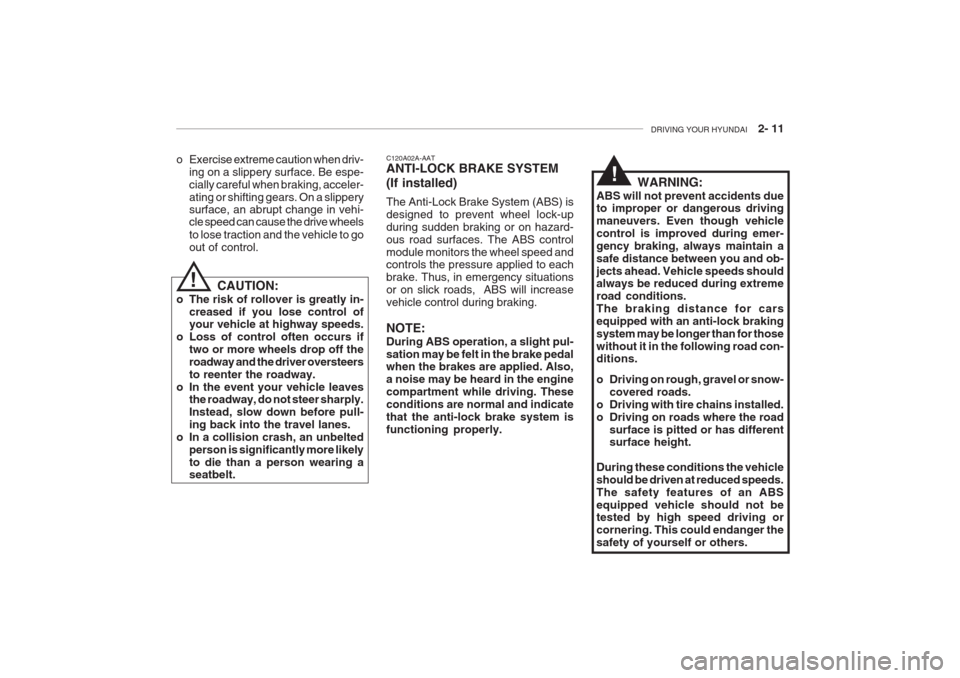
DRIVING YOUR HYUNDAI 2- 11
C120A02A-AAT ANTI-LOCK BRAKE SYSTEM (If installed) The Anti-Lock Brake System (ABS) is designed to prevent wheel lock-upduring sudden braking or on hazard-ous road surfaces. The ABS controlmodule monitors the wheel speed and controls the pressure applied to each brake. Thus, in emergency situationsor on slick roads, ABS will increasevehicle control during braking. NOTE: During ABS operation, a slight pul- sation may be felt in the brake pedal when the brakes are applied. Also, a noise may be heard in the enginecompartment while driving. Theseconditions are normal and indicatethat the anti-lock brake system isfunctioning properly. WARNING:
ABS will not prevent accidents due to improper or dangerous driving maneuvers. Even though vehiclecontrol is improved during emer-gency braking, always maintain asafe distance between you and ob-jects ahead. Vehicle speeds should always be reduced during extreme road conditions.The braking distance for carsequipped with an anti-lock brakingsystem may be longer than for thosewithout it in the following road con- ditions.
o Driving on rough, gravel or snow- covered roads.
o Driving with tire chains installed.
o Driving on roads where the road surface is pitted or has different surface height.
During these conditions the vehicle should be driven at reduced speeds.The safety features of an ABSequipped vehicle should not be tested by high speed driving or cornering. This could endanger thesafety of yourself or others.
o Exercise extreme caution when driv-
ing on a slippery surface. Be espe-cially careful when braking, acceler-ating or shifting gears. On a slipperysurface, an abrupt change in vehi- cle speed can cause the drive wheels to lose traction and the vehicle to goout of control.
CAUTION:
o The risk of rollover is greatly in- creased if you lose control of your vehicle at highway speeds.
o Loss of control often occurs if two or more wheels drop off the roadway and the driver oversteersto reenter the roadway.
o In the event your vehicle leaves the roadway, do not steer sharply.Instead, slow down before pull-ing back into the travel lanes.
o In a collision crash, an unbelted person is significantly more likelyto die than a person wearing a seatbelt.
!
!
Page 141 of 230
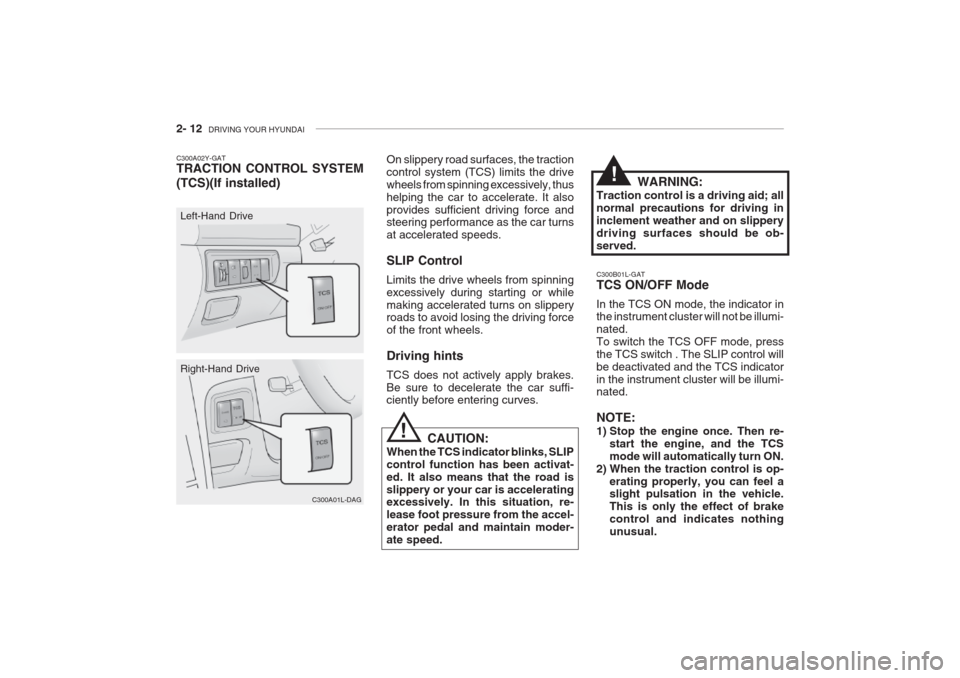
2- 12 DRIVING YOUR HYUNDAI
C300B01L-GAT TCS ON/OFF Mode In the TCS ON mode, the indicator in the instrument cluster will not be illumi- nated.To switch the TCS OFF mode, pressthe TCS switch . The SLIP control willbe deactivated and the TCS indicatorin the instrument cluster will be illumi- nated. NOTE:
1) Stop the engine once. Then re-
start the engine, and the TCS mode will automatically turn ON.
2) When the traction control is op- erating properly, you can feel a slight pulsation in the vehicle. This is only the effect of brakecontrol and indicates nothingunusual.
On slippery road surfaces, the tractioncontrol system (TCS) limits the drivewheels from spinning excessively, thushelping the car to accelerate. It alsoprovides sufficient driving force and steering performance as the car turns at accelerated speeds. SLIP Control Limits the drive wheels from spinning excessively during starting or whilemaking accelerated turns on slippery roads to avoid losing the driving force of the front wheels. Driving hints TCS does not actively apply brakes. Be sure to decelerate the car suffi- ciently before entering curves.
CAUTION:
When the TCS indicator blinks, SLIP control function has been activat-ed. It also means that the road isslippery or your car is accelerating excessively. In this situation, re- lease foot pressure from the accel-erator pedal and maintain moder-ate speed.
C300A01L-DAG
Right-Hand Drive
C300A02Y-GAT TRACTION CONTROL SYSTEM (TCS)(If installed)
C300A01L
Left-Hand Drive WARNING:
Traction control is a driving aid; all normal precautions for driving ininclement weather and on slipperydriving surfaces should be ob-served.
!
!
Page 142 of 230
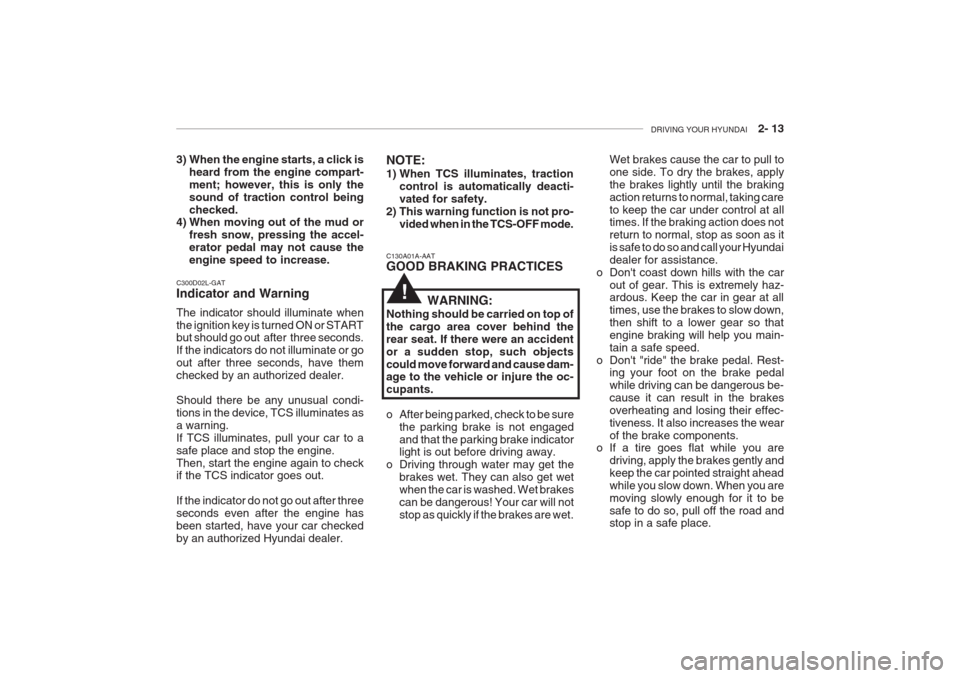
DRIVING YOUR HYUNDAI 2- 13
NOTE:
1) When TCS illuminates, traction
control is automatically deacti- vated for safety.
2) This warning function is not pro- vided when in the TCS-OFF mode.
3) When the engine starts, a click is
heard from the engine compart-ment; however, this is only thesound of traction control beingchecked.
4) When moving out of the mud or
fresh snow, pressing the accel-erator pedal may not cause theengine speed to increase.
C300D02L-GAT Indicator and Warning The indicator should illuminate when
the ignition key is turned ON or START but should go out after three seconds. If the indicators do not illuminate or goout after three seconds, have themchecked by an authorized dealer. Should there be any unusual condi- tions in the device, TCS illuminates asa warning.If TCS illuminates, pull your car to asafe place and stop the engine.Then, start the engine again to check if the TCS indicator goes out. If the indicator do not go out after three seconds even after the engine hasbeen started, have your car checkedby an authorized Hyundai dealer. C130A01A-AAT GOOD BRAKING PRACTICES
WARNING:
Nothing should be carried on top of the cargo area cover behind therear seat. If there were an accidentor a sudden stop, such objectscould move forward and cause dam- age to the vehicle or injure the oc- cupants.
o After being parked, check to be sure the parking brake is not engaged and that the parking brake indicator light is out before driving away.
o Driving through water may get the brakes wet. They can also get wet when the car is washed. Wet brakescan be dangerous! Your car will notstop as quickly if the brakes are wet. Wet brakes cause the car to pull toone side. To dry the brakes, applythe brakes lightly until the braking
action returns to normal, taking careto keep the car under control at all times. If the braking action does not return to normal, stop as soon as it
is safe to do so and call your Hyundaidealer for assistance.
o Don't coast down hills with the car out of gear. This is extremely haz- ardous. Keep the car in gear at all times, use the brakes to slow down,then shift to a lower gear so thatengine braking will help you main-tain a safe speed.
o Don't "ride" the brake pedal. Rest- ing your foot on the brake pedalwhile driving can be dangerous be-cause it can result in the brakes
overheating and losing their effec-tiveness. It also increases the wearof the brake components.
o If a tire goes flat while you are
driving, apply the brakes gently and
keep the car pointed straight aheadwhile you slow down. When you are
moving slowly enough for it to besafe to do so, pull off the road and stop in a safe place.
!
Page 143 of 230
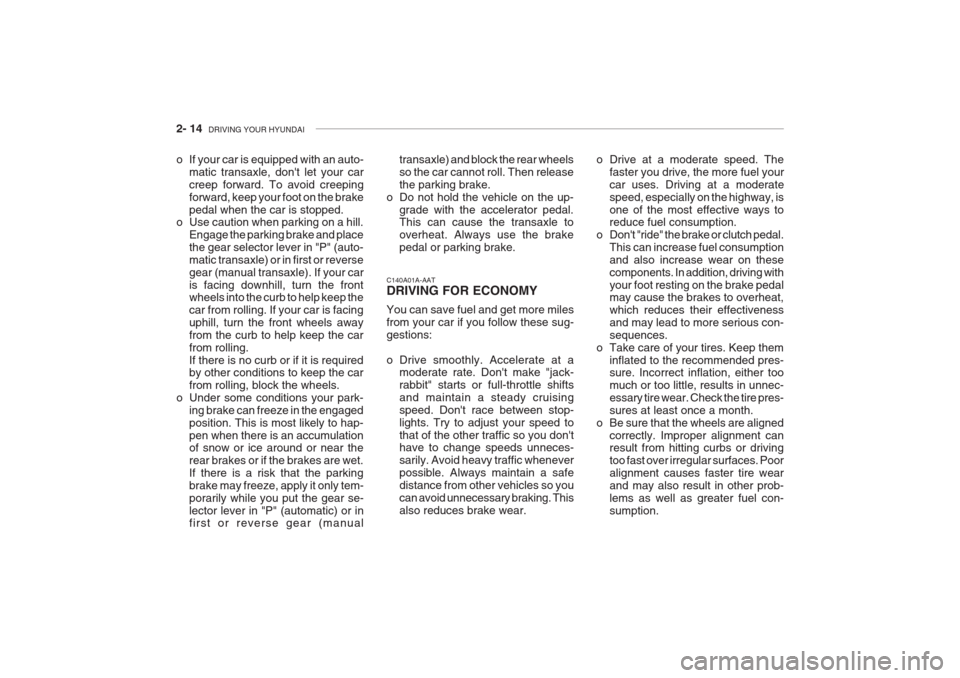
2- 14 DRIVING YOUR HYUNDAI
o Drive at a moderate speed. The
faster you drive, the more fuel your car uses. Driving at a moderatespeed, especially on the highway, isone of the most effective ways to reduce fuel consumption.
o Don't "ride" the brake or clutch pedal. This can increase fuel consumption and also increase wear on thesecomponents. In addition, driving withyour foot resting on the brake pedal may cause the brakes to overheat, which reduces their effectivenessand may lead to more serious con-sequences.
o Take care of your tires. Keep them
inflated to the recommended pres- sure. Incorrect inflation, either too much or too little, results in unnec-essary tire wear. Check the tire pres-sures at least once a month.
o Be sure that the wheels are aligned correctly. Improper alignment can result from hitting curbs or driving too fast over irregular surfaces. Pooralignment causes faster tire wearand may also result in other prob-lems as well as greater fuel con-sumption.
transaxle) and block the rear wheelsso the car cannot roll. Then releasethe parking brake.
o Do not hold the vehicle on the up- grade with the accelerator pedal. This can cause the transaxle to overheat. Always use the brakepedal or parking brake.
C140A01A-AAT DRIVING FOR ECONOMY You can save fuel and get more miles from your car if you follow these sug-gestions:
o Drive smoothly. Accelerate at a moderate rate. Don't make "jack- rabbit" starts or full-throttle shiftsand maintain a steady cruisingspeed. Don't race between stop-lights. Try to adjust your speed tothat of the other traffic so you don't have to change speeds unneces- sarily. Avoid heavy traffic wheneverpossible. Always maintain a safedistance from other vehicles so youcan avoid unnecessary braking. Thisalso reduces brake wear.
o If your car is equipped with an auto-
matic transaxle, don't let your carcreep forward. To avoid creepingforward, keep your foot on the brake
pedal when the car is stopped.
o Use caution when parking on a hill.
Engage the parking brake and placethe gear selector lever in "P" (auto-matic transaxle) or in first or reversegear (manual transaxle). If your caris facing downhill, turn the front wheels into the curb to help keep the car from rolling. If your car is facinguphill, turn the front wheels awayfrom the curb to help keep the carfrom rolling.If there is no curb or if it is required by other conditions to keep the car from rolling, block the wheels.
o Under some conditions your park-
ing brake can freeze in the engagedposition. This is most likely to hap-pen when there is an accumulation of snow or ice around or near the rear brakes or if the brakes are wet.If there is a risk that the parkingbrake may freeze, apply it only tem-porarily while you put the gear se-lector lever in "P" (automatic) or in first or reverse gear (manual